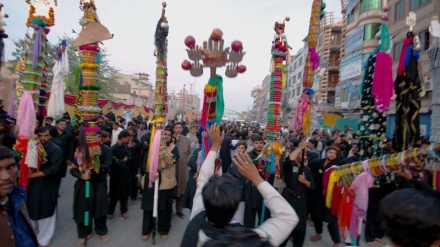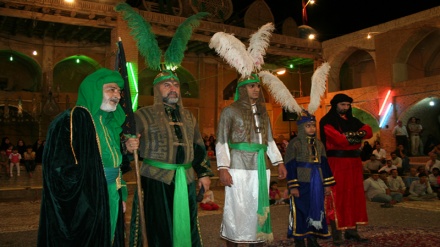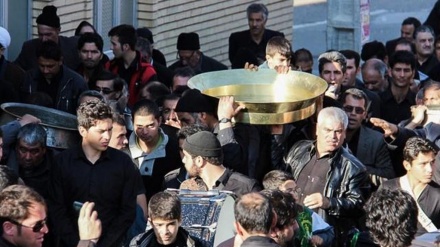Muharram mourning traditions in different lands - 40
Welcome to the 40th part of the series titled “Muharram Mourning Traditions in Different Lands” that we started broadcasting as of October 15 on a daily basis, to commemorate the heartrending tragedy of Karbala, and the martyrdom of Imam Husain (AS), the grandson of Prophet Mohammad (SAWA).
In this series, which delves into the mourning traditions associated with the Immortal Epic of Ashura, we have been focusing on the various norms prevalent in different towns and cities of Iran for commemorating the heartrending tragedy of Karbala, after having dwelt on the history of mourning in different countries of the world for Imam Husain (AS). As we mentioned yesterday, today we continue our discussion about the tradition of “Ta'ziya”, which is a form of religious drama that reminds onlookers of the heartrending tragedy of Karbala. It is also known as "Shabih Khwani".
One can watch Ta'ziya in most regions of Iran, and particularly in East and West Azerbaijan provinces, in the province of Ardebil, in the central provinces, and in Fars province in the south of the country. Ta'ziya is a religious play which shows us the events of Karbala, but other important events in Islamic history, such as martyrdom of the Prophet’s 7th Infallible Heir, Imam Musa Kazem (AS), the martyrdom of his daughter Hazrat Fatema Ma’soumah (peace upon her), and the martyrdom of his son and successor, lmam Reza (AS), and other important events in Islamic history have also been depicted in Ta'ziya. Ask any actor who has appeared in this type of religious theatre and he or she will tell you that you learn to act in Ta'ziya stage-by-stage and step-by-step. It is impossible to learn everything overnight.
You learn Ta'ziya, gradually, year after year. People who have acted in Ta'ziya will tell you that it is an art which only a limited number of people will ever master. Not everyone can become a Ta'ziya actor. You need a good clear voice, oratory skills, and the ability to speak loudly and clearly. This is very important for a Ta'ziya actor. In the past, most people who appeared as actors in Ta'ziya or religious theatre, had a family connection of some sort to this art form. For example, their father, or grandfather, or perhaps their brother or cousin was a Ta'ziya actor. But this is no longer the case today.
In the old days, particularly during the Qajar period, from 1796 to 1925, women-only Ta'ziya was also prevalent in Iran, where the entire audience and all the actors were women. All female Ta'ziya was performed in the private homes of wealthy individuals in the Qajar era, but this type of Ta'ziya became obsolete towards the end of the Qajar period, and today it no longer exists. Another type of Ta'ziya which has become obsolete is "Imprecation Ta'ziya", where the actors made sarcastic remarks about the enemies of Islam and openly cursed them for their discourteous and hostile behaviour towards the Prophet of Islam and his Blessed Household. This type of Ta'ziya is no longer performed today. Ta'ziya has changed to some extent over the years, but it is an Iranian and Islamic art form which is performed in the mourning months of Muharram and Safar, in all regions of Iran, whether north, south, east or west.
One of the biggest Ta'ziya performances in Iran takes place every year in the Husseiniyeh Hazrat Abu’l-Fazl al-Abbas, in the village of Qoodjan, near the town of Khwansar, in west-central Iran. This traditional Ta'ziya performance takes place every year, on the Day of Arba’een (20th Safar), and from 22nd to 28th of Safar. It draws a huge crowd of tens of thousands of people who travel to this village to watch this theatrical performance.
In fact, 18 different dramas, each one dealing with one particular aspect of the tragedy of Ashura, for example, Ta'ziya of Muslim ibn Aqeel (a cousin of Imam Husain PBUH), Ta'ziya Ali Akbar (son of Imam Husain PBUH), Ta'ziya Qasem (son of Imam Hasan Mojtaba PBUH, and a nephew of Imam Husain PBUH), Ta'ziya Horr ar-Riyahi (a commander of Yazid's army who joined Imam Husain on the day of Ashura), Ta'ziya Hazrat Abu’l-Fazl al-Abbas (brother of Imam Husain PBUH), and several different forms of Ta'ziya for Ashura are all performed in the same venue, in the village of Qoodjan.
Ardebil province in North Western Iran is justly famous for its Ta'ziya performances, and many different groups of actors, on the day of Ashura (10th of Muharram), perform Ta'ziya theatre in the city of Ardebil itself, as well as in towns and villages throughout the province. In the city of Ardebil, Ta'ziya performances can be seen in many squares in the city center, as well as near main mosques, in the morning, noon, and night of 10th of Muharram.
There are also travelling groups of actors in Ardebil province who travel from village to village, and from town to town, on the day of Ashura, performing Ta'ziya theatre for the general public, and followers of the Ahl al-Bayt (peace upon them), and recreating (tragic) scenes from the plain of Karbala in the year 61 AH. One of the most famous Ta'ziya actors in Ardebil province was a person called Jabbar-e Fayyaz (his real name was Alaghapounoun Jabbari). He was an expert in religious theatre, and he had his own particular style of acting in Ta'ziya. He was the best actor of his day, certainly in Ardebil province, if not in the entire country. Another very well-known and very large dramatic performance takes place every year in the village of "Sahra-Roud" in Fars province in southern Iran. About 120 actors take part in this theatrical performance in an area of about 10000 square meters, just outside the village. Over 50000 (fifty thousand) spectators are drawn to this grand gathering every year.
At the end we should just mention that Ta'ziya is a valuable instrument for transferring Islamic culture from one generation to the next. It is an effective way of introducing the younger generation to the culture of Islam.
MD/AS/ME


